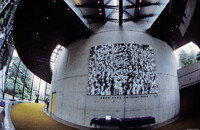| dc.description | General view of the lobby, looking east, showing the outer wall of the oval auditorium; "The Chan Centre for the Performing Arts fits snugly against the north-edge slope of the University of British Columbia, next to the rose gardens. Designed as a series of cylindrical shapes and curving in a sophisticated simplicity of detail, the Centre is sleek. Its soft grey tones are complemented by luminous panels of zinc attached diagonally across the outside curves of the concert hall. *** Although it perches before the vast expanse of Howe Sound, framed by the rugged North Shore mountains, you can't see the view for the trees. That is because the architect, Bing Thom, had it his way. *** "Some of the planners at the university said, 'Well, the most important part of the site is the view. Chop down all of the trees,'" Thom recalled of the earliest stages of his work on the Centre. "I said, 'No, no, no. The most important part of the site is the trees, because when you have a performance at night there are no views. Everything is dark, whereas if you light the forest, you will then appreciate the forest.'" *** The trees won. From the Chan Centre's two-storey glass lobby, the lighted woods give the illusion of enchantment. The glass has even been angled so the fairy-tale effect won't be marred by in-house reflections. This architectural sensitivity to the site is an important part of Thom's design philosophy, which he connects to his Chinese heritage. "I think most traditional architecture coming from Asia is much more site-oriented," said Thom. "It's probably the philosophy of the culture, where man is part of the environment rather than man trying to conquer the environment," he added. "In the West Coast, with the spirit of pioneerism, you really had to conquer the land. But Asia did not have that kind of history, so the idea of blending with the land is much more important." Source: http://www.langara.bc.ca/prm/1997/page13.htm | en_US |


